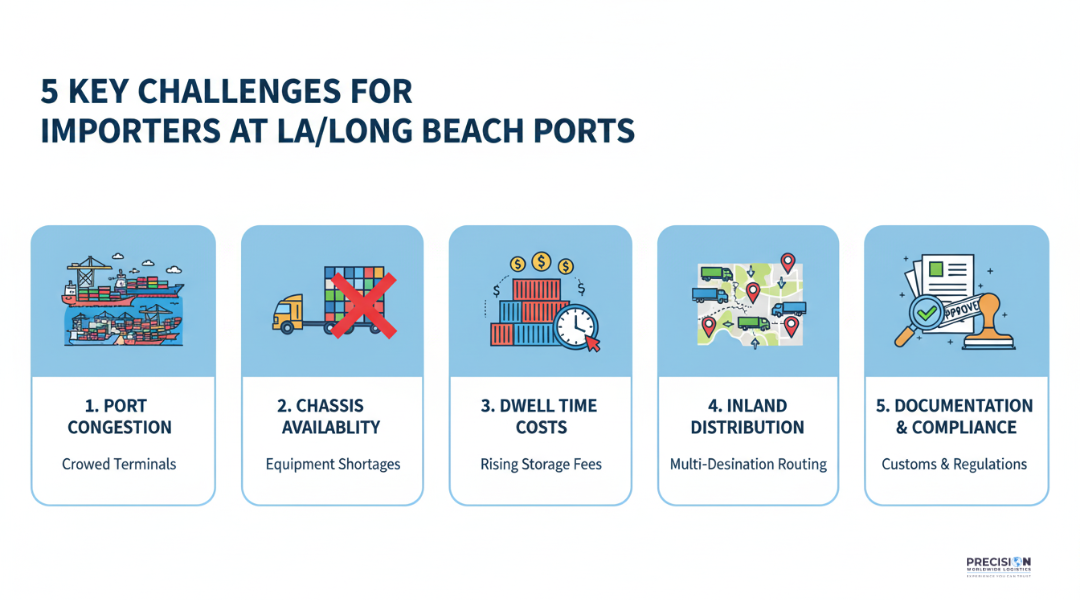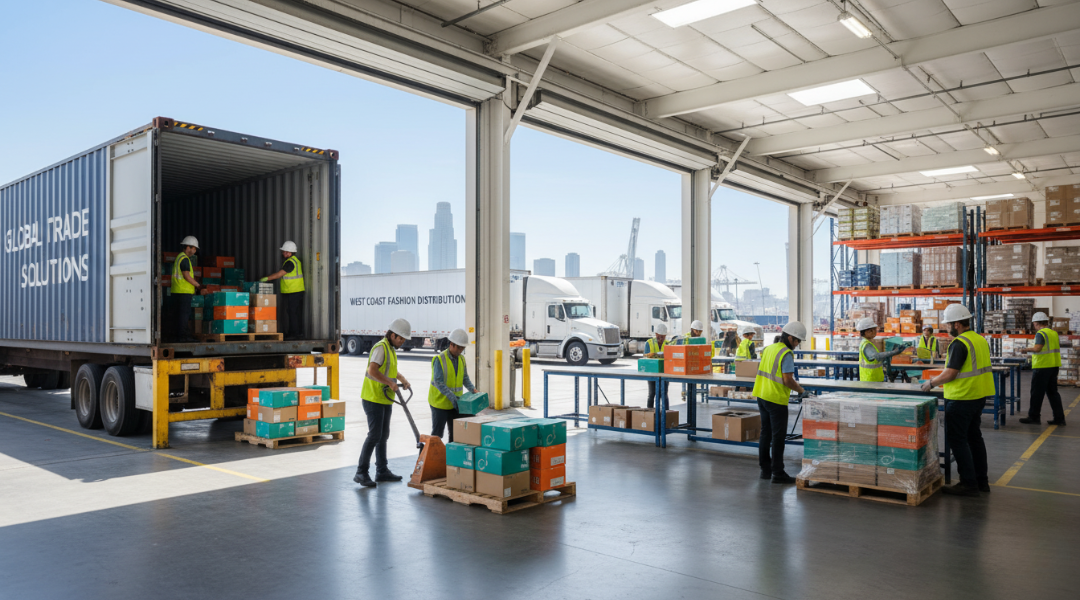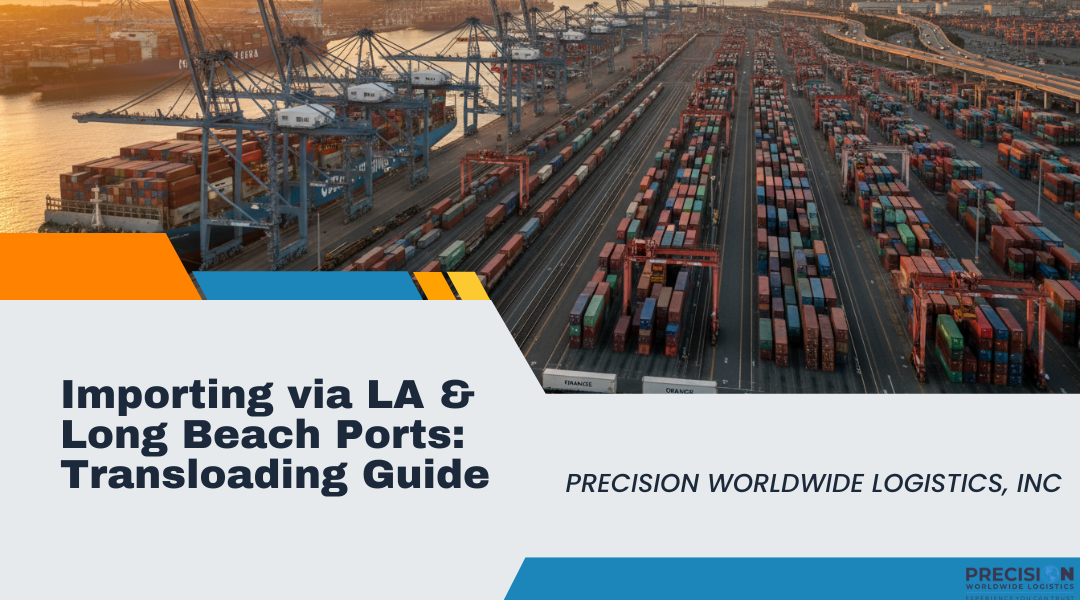Your comprehensive resource for optimizing West Coast port operations
Introduction: Why LA/Long Beach Matters for Your Supply Chain
The San Pedro Bay port complex—comprising the Port of Los Angeles and Port of Long Beach—is North America’s busiest port gateway, handling over 40% of all containerized imports entering the United States. If you’re importing goods from Asia, chances are high your containers will touch this critical supply chain node.
But here’s the challenge: getting cargo off the port efficiently can make or break your supply chain performance. Container dwell times, chassis shortages, congestion, and the “last mile” from terminal to warehouse are all potential bottlenecks that delay delivery and increase costs.
This guide explores how strategic transloading near the LA/Long Beach port complex transforms these challenges into competitive advantages.
Understanding the LA/Long Beach Port Landscape
Port Statistics at a Glance
- Combined annual volume: 18+ million TEUs (twenty-foot equivalent units)
- Geographic advantage: Closest major U.S. port to Asian manufacturing hubs
- Transit time from Asia: 12-16 days on average (vs. 24+ days to East Coast)
- Market access: Gateway to 200+ million consumers in western and southwestern U.S.
Common Challenges Importers Face

1. Port Congestion
High volume creates competition for terminal space, truck gates, and appointment slots. During peak seasons or disruption events, containers can sit for days waiting for pickup.
2. Chassis Availability
The pooled chassis system in LA/Long Beach creates dependencies on equipment availability. Without owned chassis or guaranteed access, drayage can be unpredictable.
3. Dwell Time Costs
Every day a container sits incurs costs—storage fees at terminals escalate quickly after free time expires. Demurrage charges from steamship lines add up fast.
4. Inland Distribution Complexity
Once containers leave the port, how do you efficiently get products to multiple destinations across the western U.S.? Traditional warehousing adds time and cost.
5. Documentation & Compliance
Customs clearance, ISF filing, delivery orders, and terminal release processes require expertise and coordination.
The Near-Port Transloading Solution
What Makes Location Critical?
Transloading facilities within 30 minutes of LA/Long Beach terminals offer game-changing advantages:
Immediate Container Pickup
Minimize terminal dwell time by picking up containers the same day (or next day) after vessel discharge and available notice. Avoid per-diem charges and keep containers flowing.
Reduced Drayage Costs
Short-haul drayage from terminal to nearby transload facility costs significantly less than long-distance moves. When you multiply this across hundreds or thousands of containers annually, savings accumulate quickly.
Faster Market Access
Products reach final destinations days faster compared to traditional inland warehousing. In competitive markets where speed wins customers, this advantage is substantial.
Operational Flexibility
If your final destination changes, container routing shifts, or you need to hold inventory briefly, near-port facilities provide agility that distant warehouses can’t match.
How Near-Port Transloading Works: Step-by-Step
Phase 1: Pre-Arrival Planning
Before your vessel docks, coordinate with your transloading partner:
- Provide vessel schedule and container details: Steamship line, vessel name, ETA, container numbers, and cargo descriptions
- Confirm customs clearance status: Ensure ISF is filed, customs broker is engaged, and any holds are resolved
- Define transload specifications: Final destinations, special handling needs, delivery timing
Pro tip: The best transloading partners monitor vessel arrivals and proactively communicate with you before issues arise.
Phase 2: Container Pickup from Terminal
Once the container is available for pickup (terminal releases it), your transload partner:
- Secures appointment slot at the terminal (using owned chassis eliminates wait time for equipment)
- Dispatches truck and chassis for container pickup
- Transports container directly to nearby transload facility (10-30 minute drive)
- Returns empty container to terminal quickly, avoiding per-diem charges
Time savings: Containers typically arrive at the transload facility within 4-8 hours of being released from the terminal.
Phase 3: Transloading Operations
At the transload facility, trained staff:
- Unload the container using forklifts, pallet jacks, or other appropriate equipment
- Inspect freight for damage or discrepancies
- Sort cargo by destination, SKU, or customer specification
- Repalletize or repackage as needed for optimal truck loading
- Load outbound trucks with sorted, optimized freight
- Prepare documentation including BOLs, packing lists, and delivery instructions
Typical timeframe: Most transloading operations complete within 24-48 hours of container arrival. Time-sensitive freight can often be turned same-day.
Phase 4: Final Distribution
Sorted freight departs the transload facility via:
- Full truckload (FTL) for consolidated shipments to single destinations
- Less-than-truckload (LTL) for smaller shipments going to multiple locations
- Intermodal rail for cross-country shipments where time allows
- Regional delivery trucks for final-mile service in Southern California
Destination flexibility: One container can become 5+ different shipments, each optimized for its specific route and delivery requirements.
Key Benefits: By the Numbers
Speed Improvements
- Traditional approach: Port → Inland warehouse (1-3 days) → Sort and store (1-5 days) → Outbound shipping (1-7 days) = 3-15 days total
- Near-port transloading: Port → Transload facility (same day) → Sort and reload (1-2 days) → Direct shipping = 1-3 days total
Result: 2-12 days faster market delivery
Cost Reductions
- Drayage savings: 30-50% lower compared to long-haul inland moves
- Avoided demurrage: $100-200 per container per day after free time
- Reduced storage costs: Minimal facility time vs. weeks in traditional warehousing
- Transportation optimization: Consolidating partial loads saves 20-40% on per-unit shipping
Average savings: $300-800 per container across all cost factors
Operational Improvements
- Container velocity: 3-5x faster turnaround from vessel discharge to empty return
- Inventory turns: Faster product flow reduces carrying costs
- Supply chain agility: Ability to respond to demand changes or routing adjustments
- Reduced SKU complexity: Sort and distribute at the port rather than managing at multiple downstream locations
Industry-Specific Applications at LA/Long Beach
Retail & Apparel
Challenge: Fast-changing trends and promotional calendars demand rapid replenishment.
Solution: Import containers transload into store-specific or DC-specific truckloads within 24 hours of port arrival. Products hit shelves days faster than traditional distribution.
Example: A national apparel retailer receives 100 containers monthly. Transloading near the port allows them to bypass their inland DC for direct store delivery, cutting 5-7 days from their supply chain and reducing markdowns from late-arriving seasonal goods.

Electronics & Technology
Challenge: High-value products in small packages require security and speed.
Solution: Transload into secure, tracked LTL or parcel shipments directly from port, avoiding long warehouse holds and their associated risks.
Example: A consumer electronics brand uses near-port transloading to sort and ship to regional distribution centers and major retailers simultaneously, ensuring coordinated product launches across the West Coast.
Furniture & Home Goods
Challenge: Bulky, heavy products with high freight costs per unit.
Solution: Consolidate multiple supplier containers into optimized full truckloads for specific regions, dramatically reducing per-item transportation costs.
Example: A furniture importer receives containers from 5 different Asian manufacturers. Transloading allows combining slow-moving items from multiple containers into single regional deliveries, cutting transportation costs by 35%.
Automotive Parts
Challenge: Just-in-time manufacturing requires precise timing and reliability.
Solution: Transload import containers into expedited truck shipments timed to arrive at plants exactly when needed—no early, no late.
Example: An auto parts supplier serves assembly plants in California, Arizona, and Nevada. Near-port transloading enables same-week delivery from vessel arrival, maintaining lean inventory at plants.
Food & Beverage
Challenge: Perishable products demand cold chain integrity and rapid distribution.
Solution: Transload from reefer containers into temperature-controlled trucks within hours, maintaining product quality throughout the supply chain.
Example: An organic food importer uses near-port transloading for frozen goods, ensuring products spend minimal time in the import process and maximum shelf life for consumers.
Choosing the Right Transloading Partner
Location, Location, Location
Proximity to terminals matters. A facility 10 minutes from the port saves dramatically compared to one 60+ minutes away:
- Lower drayage costs per container
- Faster response to terminal appointments
- Ability to make multiple daily terminal runs if needed
- Reduced fuel costs and driver time
Precision Worldwide’s La Mirada facility sits less than 30 minutes from both LA and Long Beach terminals—close enough for efficiency, far enough to avoid port-area congestion and higher real estate costs.
Asset-Based vs. Brokerage Operations
Asset-based providers (like Precision) own their trucks, chassis, and equipment:
✓ Guaranteed capacity—not competing for third-party resources
✓ Better cost control and predictable pricing
✓ Faster response times during peak seasons
✓ Single point of accountability
Brokers coordinate services through third parties:
✗ Subject to market capacity constraints
✗ Variable pricing based on spot market rates
✗ Potential delays when capacity is tight
✗ Multiple vendors to manage
In the LA/Long Beach chassis-constrained environment, owning equipment is a significant competitive advantage.
Integrated Services
Look for partners offering complete solutions beyond just transloading:
- Customs brokerage coordination: Streamlined clearance process
- Warehousing options: Short or long-term storage when needed
- Value-added services: Labeling, kitting, inspection, quality control
- Transportation network: FTL, LTL, and intermodal options
- Technology integration: Real-time tracking, inventory visibility, reporting
One partner managing the entire flow from port to customer delivery simplifies operations and improves accountability.
Experience & Reputation
Southern California port logistics is complex—experience matters:
- How many years has the provider operated at LA/Long Beach?
- Do they have established relationships with terminals and steamship lines?
- Can they provide references from similar businesses?
- What’s their track record during disruption events (labor actions, congestion spikes)?
Precision’s 25+ years in the LA market means we’ve navigated every challenge the port has thrown at importers—and we know how to keep freight moving.
Common Mistakes to Avoid
Mistake #1: Choosing Distant Warehousing to Save Rent
The problem: Lower warehouse rent in distant locations gets negated by higher drayage costs, longer transit times, and reduced flexibility.
The solution: Calculate total landed cost including drayage, time value, and opportunity costs. Near-port transloading often delivers better ROI despite higher per-square-foot facility costs.
Mistake #2: Not Planning for Peak Season Capacity
The problem: Everyone ships for Q4 holidays. Without established relationships and reserved capacity, your containers sit at the port while equipment and labor go elsewhere.
The solution: Partner with transloading providers well before peak season. Lock in capacity commitments and develop contingency plans.
Mistake #3: Overlooking Value-Added Service Opportunities
The problem: Treating transloading as purely a transfer point misses chances to improve downstream operations.
The solution: Consider inspection, relabeling, kitting, or other services during transloading. A small investment here can save significant time and money downstream.
Mistake #4: Poor Communication with Supply Chain Partners
The problem: Transloading requires coordination between multiple parties—freight forwarders, customs brokers, trucking companies, receivers. Communication gaps cause delays.
The solution: Choose a transloading partner who proactively manages coordination and keeps all parties informed. Technology that provides visibility helps significantly.
Mistake #5: Failing to Track and Optimize Over Time
The problem: Without metrics, you can’t identify improvement opportunities or problems before they become crises.
The solution: Implement KPIs like average dwell time, cost per container, transit time, and damage rates. Review regularly with your transloading partner to drive continuous improvement.
Technology’s Role in Modern Transloading
Real-Time Visibility
Modern transloading partners provide:
- Container tracking: From vessel to terminal to transload facility to final destination
- Inventory visibility: Know exactly what’s in-process at any moment
- Document access: BOLs, packing lists, photos all accessible digitally
- Exception alerts: Proactive notifications of delays or issues
Data-Driven Optimization
Historical data analysis enables:
- Cost trending: Identify savings opportunities across your container flows
- Performance benchmarking: Compare different suppliers, routes, or seasons
- Predictive planning: Forecast capacity needs based on historical patterns
- Continuous improvement: Make data-backed decisions about supply chain adjustments
Integration Capabilities
Best-in-class systems connect with:
- Your ERP or warehouse management system
- Customs broker systems for clearance status
- Steamship line systems for vessel tracking
- Customer systems for delivery confirmation
Seamless data flow reduces manual work and error rates.
Sustainability Considerations
Near-port transloading contributes to environmental goals:
Reduced Trucking Miles
Shorter drayage hauls mean less fuel consumption and emissions per container. When multiplied across thousands of containers, the carbon reduction is substantial.
Optimized Load Consolidation
Fuller trucks traveling optimal routes produce lower per-unit emissions than multiple partially-filled trucks. Transloading enables this consolidation.
Intermodal Opportunities
For cross-country distribution, transloading to rail after port entry reduces CO2 emissions by up to 75% compared to long-haul trucking.
Reduced Port Congestion
Faster container turnaround means fewer trucks idling in terminal queues and less port-area congestion overall—benefiting the entire Los Angeles basin air quality.
For companies with ESG commitments, near-port transloading aligns with sustainability targets while improving operational performance.
Getting Started with Near-Port Transloading
Step 1: Assess Your Current State
Evaluate your existing import process:
- What’s your average cost per container from port to final destination?
- How long does freight spend between vessel arrival and outbound shipment?
- What percentage of containers incur demurrage or storage fees?
- How much flexibility do you have when plans change?
Step 2: Define Your Requirements
Clarify your transloading needs:
- Container volume (monthly/annually)
- Types of cargo and special handling requirements
- Destination mix (how many locations per container?)
- Service level expectations (speed vs. cost priorities)
- Value-added services needed (labeling, inspection, etc.)
Step 3: Evaluate Partners
Interview potential transloading providers:
- Facility tour: See operations firsthand
- Reference checks: Talk to current clients
- Technology demonstration: Understand visibility capabilities
- Pricing structure: Get transparent, detailed quotes
- Scalability discussion: Ensure they can grow with your business
Step 4: Pilot Program
Start with a manageable test:
- Select a subset of containers for initial transloading
- Establish clear success metrics
- Monitor closely and gather feedback
- Compare results to traditional approach
- Refine processes based on learnings
Step 5: Scale and Optimize
Once validated, expand the program:
- Transition more container volume to transloading
- Implement continuous improvement processes
- Leverage data to optimize routing and consolidation
- Explore additional value-added services
- Build long-term partnership with your provider
Precision Worldwide Logistics: Your LA/Long Beach Port Solution
At Precision Worldwide Logistics, we’ve spent over 25 years perfecting near-port transloading for importers using the LA/Long Beach gateway.
What Sets Us Apart
Strategic La Mirada Location: Less than 30 minutes from both port complexes—close enough for efficiency, optimally positioned for inland distribution
Asset-Based Operations: We own our trucks and chassis pool, ensuring reliable capacity when you need it most
Comprehensive Services: From port pickup through final delivery, plus warehousing, fulfillment, and value-added services
Experienced Team: Veteran logistics professionals who know LA port operations inside and out
Technology-Enabled: Real-time visibility, integrated systems, and data-driven optimization
Customer-Centric: We treat your freight as our own, providing the high-touch service and communication you deserve
Our Transloading Process Delivers Results
- Average container turnaround: 24-36 hours from facility arrival to outbound departure
- Same-day service available: For time-critical freight
- Flexible capacity: Handle volume surges without compromising service
- Safety record: Industry-leading damage rates and cargo security
- Sustainability focus: Optimized operations that reduce environmental impact
Ready to Transform Your Port Operations?
If you’re importing through Los Angeles or Long Beach ports and looking to:
✓ Reduce costs from port to final destination
✓ Speed products to market
✓ Improve supply chain flexibility
✓ Eliminate headaches from chassis shortages and port congestion
✓ Gain better visibility into freight status
Let’s talk about how near-port transloading can transform your supply chain.
Contact Precision Worldwide Logistics
📞 Call: (800) 937-1599
✉️ Email: [email protected]
🌐 Visit: www.precisioninc.com
Our logistics experts are ready to analyze your current operations and design a customized transloading solution. Request a free consultation and quote today—discover how Precision’s LA port expertise can give you a competitive advantage in today’s demanding logistics environment.
Precision Worldwide Logistics – 25+ Years of Excellence in Southern California Port Logistics

